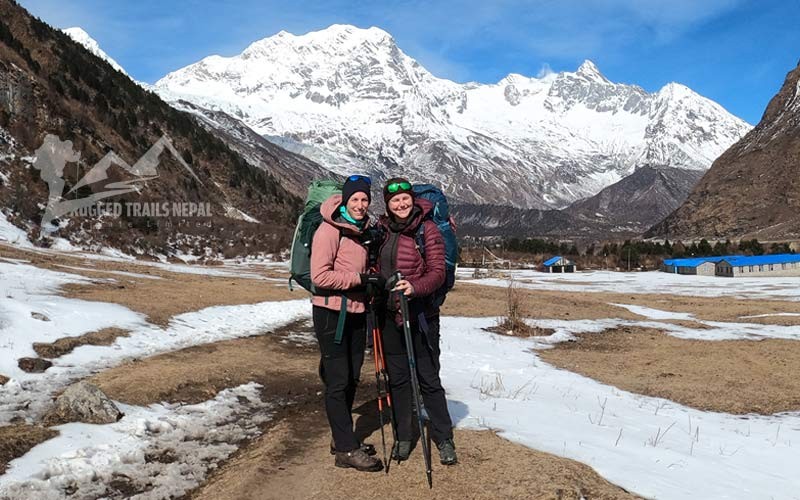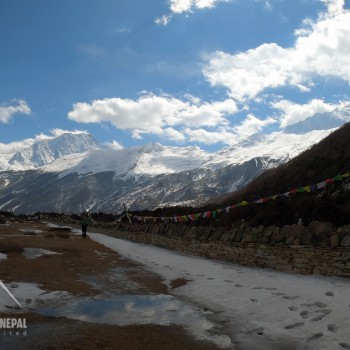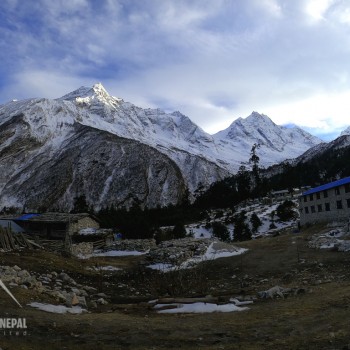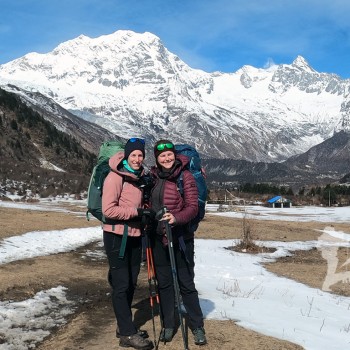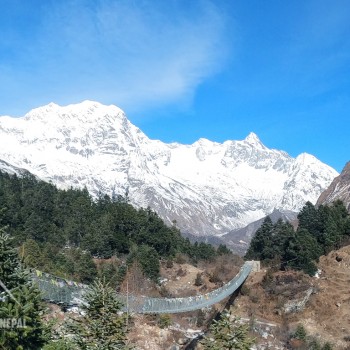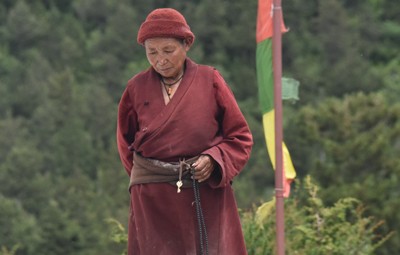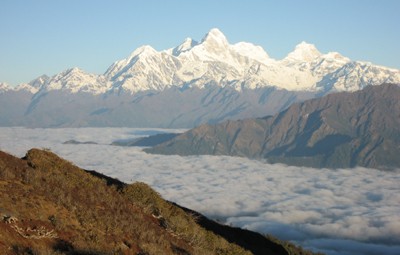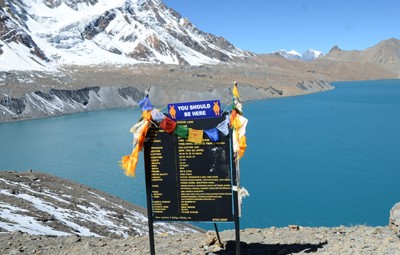The Manaslu Circuit Trek is a challenging, high-altitude journey around the world's eighth-highest mountain, Mount Manaslu (8156 m), often considered a less-crowded alternative to the Annapurna Circuit. This rewarding trek combines the best of both the Manaslu and Annapurna regions. The trail starts at a low elevation and ascends gradually, reaching its highest and most spectacular point at the Larkya La Pass (5106 m / 16752 ft), which offers stunning panoramic views of the Himalayas. The adventure provides a unique blend of natural beauty and cultural immersion in remote, authentic villages.
Let's celebrate together "Visit Nepal 2025", Get amazing discounts for group travelers!
- Duration15 Days
- Price from$1495/ person
- Difficulty LevelStrenuous
- Max Altitude5,106 M (16,752 ft)
The Manaslu Circuit Trekking is one of the very best treks in Nepal. Almost unheard of by most visitors to the country, it is a hidden gem and will blow you away with its raw beauty. The trip around Manaslu (8156 meters / 26,758 feet) is a challenging one, though exceptionally rewarding for those who brave the path. Stay in beautiful villages, cross suspension bridges over rushing rapids, and traverse high passes in this adventurous trek.
The Manaslu Circuit Trek joins the Annapurna region with the Manaslu region, and you truly get the best of both. Many guides say the trail is comparable to the Annapurna Circuit Trek but with fewer tourists. The amazing scenery never stops. From the forests, teeming with life at the beginning of the trail, to the barren, rocky landscape above the clouds, you will constantly be in awe. Free your mind for a bit on the Manaslu Circuit Trekking. Your biggest worry will be, ‘Where is the next best view?’
Manaslu Circuit Trek Highlights
- World Heritage Sites Visit in Kathmandu.
- Scenic drive and a short hike on the world’s best trek trail, Annapurna Circuit.
- Exploring rivers, waterfalls, and landscapes.
- Raw lifestyle of remote people, Tibetan Buddhism, and monasteries.
- Amazing Mt. Manaslu and the other Himalayas.
After hopping out of the car, the beauty of Manaslu greets us. Pass through Gurung and other ethnic villages and experience their warm hospitality. Because so few trekkers take the Manaslu Circuit Trek, we are welcomed with open arms. There is a saying, ‘Guest is God,’ and in these areas, the residents truly practice this phrase.
As we climb higher and move closer to the Tibetan border, the population is nearly all ethnically Tibetan, and a different language is even spoken. It does not take long to realize that half of the appeal of trekking in the Himalayas goes beyond mountain views. The rich culture of the hills and mountains is invaluable. You will look at your own life differently after spending a few weeks in the various teahouses and homestays along the trail.
Beginning from Soti Khola (700 meters), the trail is almost a continuous climb up the Budhi Gandaki River. At certain points, we must zig-zag up the vertical cliffs that guide the river. The area is home to a number of wild animals, including the musk deer, and even the snow leopard higher in the alpine territory.
At last, we reach the Larkya La (pass). At 5106 meters / 16,752 feet), it’s the highest point of our trek as well as the most mesmerizing for most people. To reach it, we walk by four frozen lakes. At the top, feast your eyes on Himlung Himal (7126 meters), Cheo Himal (6820 meters), Gyaji Kung (7030 meters), Annapurna II (7937 meters), and many rugged peaks. It’s a moment you’ll never forget! From here, we descend to Dharapani and then to Besisahar. Soon, we’ll be back in Kathmandu for the farewell dinner.
What is the best time of year to do the Manaslu Circuit Trek?
- Autumn/Fall
In Nepal, September through November are the ideal times to go hiking. With bright sunny days and great visibility, the weather is dry and clear. Additionally, because there are fewer chances of weather-related natural disasters, this is the safest time to go trekking.
The price of the Manaslu Restricted Area Permit (RAP) during this season is a disadvantage of the Manaslu Trek. The RAP generally costs $75 per week; however, during the busiest times, the price jumps to $100 per week. This is the busiest trekking season in Nepal, so the routes are also busier at this time.
- Spring Season
The second-best option is said to be the spring season, which runs from March to May. In general, the sky is clear, although it is a little chilly, especially at higher elevations. Flowers are in bloom, and the mornings are sunny. However, there is a higher probability of snow.
- Summer Season
The Manaslu Circuit Trek should be avoided from June to August. The monsoon season brings warm and humid weather, as well as poor visibility due to clouds and mist. There is a high risk of landslides on the Manaslu trail, and leeches are also a major problem during this time of year. Although we have successfully completed numerous treks during this time, we still recommend that you change your plans to a location with less risk of landslides, such as Langtang or the Annapurna region.
- Winter Season
Higher altitudes experience freezing temperatures from December to February. Due to snow and ice, this time of year is not suitable for the Manaslu Circuit Trek. We generally do not recommend or operate scheduled group treks during the deep winter months (December-February) due to extreme cold, heavy snow on the pass, and increased risk. Private trips may be possible for experienced climbers.
How difficult do trekkers find the Manaslu Circuit Trek?
Some people describe the Manaslu Circuit Trek as being difficult, strenuous, and hard. The trails are in good condition and do not require any technical skills. However, the trails can be difficult depending on the time of year, such as during landslides or heavy snowfall. The trail is also a bit slippery, so extra care is needed. The most important thing is your effort. You will ascend in altitude from 700 to 5106 meters. There will be ups and downs, river crossings, and more ascending. This process clearly indicates that physical effort is required. You must be fit, but you do not need to be an athlete or a professional trekker. People of all ages can complete the Manaslu Circuit Trek, as long as they are physically fit and keep their pace while walking. If you choose to carry all your own gear, clearly it will be more challenging. That's why we arrange for Porters to carry your gear, and you just need to carry your personal things such as wallets, cameras, and water for the day. Clearly, the Manaslu circuit trekking package is not for beginners.
How long does the Manaslu circuit trek take?
The Manaslu Circuit Trek is a rewarding experience, and while it can be completed in an accelerated 12–13 days for those in excellent shape, we strongly recommend a 15-day itinerary. This duration is carefully paced to allow ample time for altitude acclimatization, ensuring safety and a better opportunity to enjoy the stunning Himalayan scenery and cultural exploration. Furthermore, the 15-day plan generally factors in the time required for securing the special permits mandatory for this Restricted Area Trek, a process that can take up to a full day and is often overlooked in shorter schedules offered by other companies.
In line with our commitment to providing the best trekking experience, we have updated our standard itinerary from 16 days to 15 days, effective [March 1, 2026]. This change is a direct response to recent road expansions up the valley. By shifting our starting point to Machhakhola (instead of Soti Khola), we eliminate the less enjoyable and less rewarding road walking from the lower sections. This allows us to maximize the time spent on the pristine mountain trails, focusing your journey entirely on the authentic, high-altitude beauty of the Manaslu region. If you have extra time available, the 15-day schedule is easily extendable, giving you the flexibility to explore side treks like the beautiful Tsum Valley.
Benefits of a 15-day Manaslu Circuit Trek itinerary:
- More time to acclimatize to the altitude: This is important to avoid altitude sickness.
- More time to explore the region: There are many beautiful villages, monasteries, and temples to see on the Manaslu Circuit Trek.
- More time to enjoy the scenery: The Manaslu Circuit Trek is one of the most scenic treks in the world.
What permits do I need for the Manaslu Circuit Trek in 2026?
To trek in the Manaslu region, you must obtain three different permits issued by the government of Nepal. You must travel with a government-approved trekking company because the Manaslu region is a restricted area. You must also have two people to obtain the Manaslu Restricted Area Permit.
The Department of National Parks and Wildlife Conservation in Kathmandu is responsible for issuing the Manaslu Conservation Area Project (MCAP) permit. The Department of Immigration in Pokhara and Kathmandu is responsible for issuing the Manaslu Restricted Area Permit (RAP). As the Manaslu trail ends in the Annapurna Conservation Area, the Department of National Parks and Wildlife Conservation in Kathmandu is responsible for issuing the Annapurna Conservation Area (ACAP) permit.
The fees for the trekking permits vary depending on your nationality and the time of year you are trekking. The Manaslu trek permit from September to November (autumn) will cost USD 100 for the first seven days and USD 15 for each additional day. The Manaslu trek permit from December to August (winter, spring, and summer) will cost USD 75 for the first seven days and USD 10 for each additional day. From 2024 Autumn, there is another additional fee added for Manaslu Circuit Trek, which is 1000 rupees for foreigners and 200 rupees for Nepalese trekkers. The additional fees will be collected by the Chumnubri Rural Municipality after entering the Manaslu Conservation Area.
The Manaslu Conservation Area Permit Fee is as follows:
- SAARC nationals: NRs. 1,000 per person
- Other nationals: NRs. 3,000 per person
The Annapurna Conservation Area Permit Fee is as follows:
- SAARC nationals: NRs. 1,000 per person
- Other nationals: NRs. 3,000 per person
To obtain the Manaslu Restricted Area Permit (RAP), you must show your original passport to the Department of Immigration. You will also need to provide three passport-sized photos. Rugged Trails Nepal will arrange for the other documents, such as the trek itinerary, official documents from the trekking company, and copies of current staff insurance.
What gear do I need for the 15-day Manaslu Circuit Trek?
This Manaslu Circuit is a teahouse trek, so you don't need much specialist gear or equipment. We won't need to carry food, as this is a teahouse trek. However, there are a few essential items. Please follow the link to get an idea of the trekking gear you will need.
What are the dangers of the Manaslu Circuit Trek?
Altitude sickness is a major concern for trekkers on any high-altitude trek, including the Manaslu Circuit Trek and the Everest Base Camp Trek. The 15-day Manaslu Circuit Trek itinerary allows for acclimatization days, but it is still important to consult with your doctor if you are considering taking preventative medication like Diamox. You should also have a clear understanding of how to take this medication.
The Manaslu Circuit Trek involves reaching a maximum elevation of 5,106 meters at the Larkya La Pass. This altitude can cause altitude sickness for some trekkers. Altitude sickness can cause symptoms such as headaches, nausea, dizziness, and shortness of breath.
Helpful tips to help prevent altitude sickness:
- Acclimatize gradually by ascending to higher altitudes.
- Drink plenty of fluids, especially water.
- Eat light meals and avoid alcohol and caffeine.
- Follow your doctor's instructions when taking Diamox.
- Listen to your body and descend to a lower altitude if you start to feel unwell.
- Share with your guide your difficulties.
Do I need to have travel insurance for the Manaslu Trek?
Yes, it is compulsory to have travel insurance that covers search and rescue and medical evacuation for the Manaslu Circuit Trek. It is also important to check the exclusions of your policy carefully. We have listed some of the top best travel isurance for Nepal Trekking, follow the link to get the details.
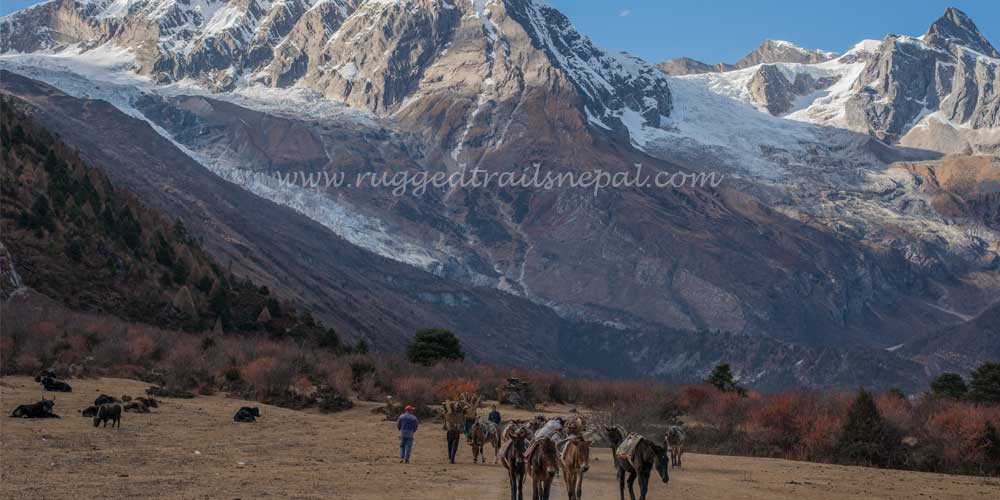
What are the cultural highlights of the Manaslu Circuit Trek?
In Manaslu, Buddhism is the most practiced religion. Local pilgrims congregate at the gorgeous monasteries in this area. The strong sense of heritage and manner of life that these monasteries display. Four significant gompas—Buddhist monasteries—are located around Manaslu: Mu Gumba (3,510 meters), Gumba Lungdung, Rachen Gumba, and Sarang Gumba. The majority of people who live on the lower slopes of the Manaslu region practice Hinduism. You will, however, also pass through significant local temples and shrines while hiking this trek.
- The biggest festival that the Tibetan and Sherpa people of the Manaslu region celebrate is Lhosar.
Helpful Links and Tips
Itinerary
You have landed on the right page if you are ready to tackle the Manaslu Circuit Trek. Many trekkers say it is a great choice if you are picking this trek. Hikers who have done the Everest Base Camp, Langtang, and Annapurna treks recommend this trek because of the diverse and impressive scenery. Additionally, the Tibetan cultural influences at higher altitudes lend a unique flavor to the experience that is notably different from other areas.
Below, on this 15-day Manaslu Circuit Trek, you will find all the details of the trip plan. If you are not happy with the below suggestion, please feel free to write to us.
- Day: 1
Arrive Kathmandu, Nepal.
Upon your arrival at the Kathmandu airport, you will be greeted by a representative from Rugged Trails Nepal who will take you to your hotel. Welcome drinks upon arrival at the hotel, free time until 6 pm. Evening welcome dinner in a traditional Nepali Restaurant with authentic Nepali cuisine and cultural program.Overnight in Kathmandu Hotel. If you arrive late at night, your dinner will be the next day.
- Day: 2
Full Day Kathmandu Sightseeing.
After breakfast proceeds with our short guided sightseeing tour at the Swayambhunath Temple. After the Swayambhunath temple, we will visit another UNESCO World Heritage site Patan Durbar Square, and a Buddhist shrine (Bouddhanath), one of the largest stupas in the world.
After sightseeing drives back to the hotel and briefing on the rest of the trip plan. At the same time if you have to buy any trekking gear or things for the rest of the day Guide will help take you to the trekking equipment store in Thamel.
Today we will arrange the special trek permits and Manaslu Conservation permits. It takes one working day to prepare the tickets.
- Day: 3
Kathmandu Roadtrip to Machha Khola.
We will start our journey to the Manaslu Circuit after having breakfast in the hotel. In the morning, your guide will come to receive you, and then the road trip to Machhakhola begins. Since the roads are a mix of paved and unpaved sections, the ride will be bumpy and a bit adventurous. You will enjoy the scenic drive with beautiful Himalayan views, countryside, and farmland. The road trip is about 160 km from Kathmandu.
The trek used to start from Sotikhola, but due to the extension of the roads, we have changed the trek itinerary, starting from Machhakhola onwards. The roads continue further to Jagat and Philim, but it's nice to walk up to this point, and there are no more vehicle crowds. Our first night will be in Machhakhola, where we will have rooms with attached bathrooms and nice hotels.
- Day: 4
Machha Khola Trek to Jagat.
As usual, the day will start with breakfast. Our guide will give you the daily trail information during breakfast and before going to bed. Mostly today we will see Gurung People village, Tatopani (Hot Spring) a short break will be here. We will cross the Budhigandaki river and ups and downs is normal on this trail but picturesque landscape. Overnight at Jagat Tea House.
- Day: 5
Jagat Trek to Deng.
We will see small rivers, streams, roaring BudhiGandaki river, millet field, bamboo forest, and beautiful landscapes. Overnight at Deng Tea House.
- Day: 6
Deng Trek to Namrung.
From today we can the real taste of the Manaslu region with lush forest, beautiful villages of ethnic groups, different alpine vegetation and the roaring Budhi Gandaki river. We can see snowcapped Siring Himal. Overnight at Namrung village.
- Day: 7
Namrung trek to Samagaon.
Normally on the trek, it's better to wake up early and explore the village and see the Morning activities of Locals. People worship and pray early morning around Stupas, at their house. We can see Ganesh Himal, Soth Mount Himal Culi, Simanang Himal, and Manaslu from the Lho village. This trail is more spiritual with the stupas, ancient Gompa, and at Samagaon village we will be surrounded by the snowcapped mountains Peak 29, Himal Chuli, Manaslu, Ganesh Himal. Overnight at Samagaon.
- Day: 8
Samagaon - Pungyen gompa - Samagaon.
Acclimatization day means rest day but don't think it's a sleeping day. Many trekkers think to sleep but we don't recommend to sleep and being lazy at the Tea House. Our guide will take you around to the Sama village to see the Sherpa culture, and a short hike up to Pungyen Gompa. We can see many ancient stone-carved texes around, enjoy the day at Samagaon.
- Day: 9
Sama Gaon Trek to Samdo.
Following the beautiful mountains which take us closer to the Tibetan Border. More we getting higher mountain views are beautiful, easy trek today. Overnight at Samdo.
- Day: 10
Rest Day in Samdo.
Today is the last rest and Acclimatization day of the Manaslu Circuit Trek. Here are few ancients Trade routes to Tibet and our guide will take you around. Depends on your physical, and weather condition guide will decide where and which area to explore. Overnight at Samdo.
- Day: 11
Samdo Trek to Dharamsala.
You might feel the elevation changes today, minor headache is normal. Drink plenty of water, and carry with you too. Walking on the higher elevation water is most important, drink water as much as you can. After breakfast, we will start our day towards Dharmasala through Tibetan Market, Budhi Gandaki river, and glaciers. We have a big day tomorrow and today is quite easier and rest.
- Day: 12
Dharmasala Trek to Bimthang crossing over Larkya La Pass 5,106 M (16,752 ft).
Today is the main highlights of the Manaslu Circuit Trek, we will have early breakfast at Dharmasala and start our adventure towards Larkya La Pass. In the afternoon generally, it will be windy so we try to cross the pass as faster as we can. Follow the guide instructions! We will be walking on the glaciers and the view is just spectacular from the Larkya peak. Pretty long day and our night at Bimthang village.
- Day: 13
Bimthang Trek to Tilije
After eating breakfast in Tilije, we set out on our daily journey, passing by a quiet waterfall, a steep cliff, and a secret valley. We will pass through Hampuk Cave, Puktu Kharka, Karche Pass, and Gho Village en route. Both towns are encircled by verdant forests, terraced farmland, and imposing mountains that provide a breathtaking outlook.
The region between Bimthang and Tilche is home to a wide variety of flora and animals as well as hamlets. It is a rural valley where trekkers in Nepal can take in the splendor of the natural world.
- Day: 14
Tilije Trek to Dharapani 1980 M - Drive to Kathmandu
The last day of the trek is today. From Tilije, we will trek toward Dharapani, passing through lovely villages and up to the Mani walls. Additionally, Dharapani serves as the launchpad for the well-known Annapurna Circuit Trek. After arriving in Dharapani, we'll take a shared jeep ride to Beshisahar, where we'll switch to a different vehicle to transport us to Kathmandu. Transfer to your accommodation in Kathmandu after making the return trip.
- Day: 15
Final Departure.
Transferred to the international airport on your flight schedule and if some have extra days in Nepal they will continue with other activities. If any help is needed for further plans feel free to contact the Rugged Trails Nepal team.
What's Included
- Airport Pickup and Drop.
- 3 Nights of Hotel accommodation in Kathmandu on B/B
- Guided city tour of Kathmandu heritage sites.
- Full Board (breakfast, lunch, and Dinner) in Trekking
- Accommodation during the trek (local lodge).
- Government-registered English-speaking local expert guides, and porters.
- Annapurna and Manaslu Conservation Park fees.
- Manaslu Trek permits government taxes.
- Farewell dinner in the city
- Equipment and clothing for porters and staff.
- Insurance for all staff and porters.
- Ground transportation to and from the starting and ending points of the trek (depending on the price)
- First Aid Kit for Manaslu Circuit Trek.
- Manaslu Trekking Map.
- Salary, allowances, expenses, & insurance for all staff, including porters.
- Sleeping bags, duffle bags.
What’s Excluded
- Nepal visa: Multiple Entry (30 days): USD 50
- Lunch and dinner during hotel stay in Kathmandu
- Personal gear and clothing (available on hire)
- Tips for guides and porters.
- Personal insurance and medical evacuation in case of emergency.
- Services other than those mentioned above
- Expenses incurred due to accidents, landslides, strikes, political unrest, etc.
- Hot shower, battery charge (during the trek), international telephone calls, etc.
- Items of personal nature such as alcoholic drinks, cold drinks, laundry, and mineral water
- Entrance fees are required to enter Kathmandu heritage sites.
Availabilities
Departure Note
The Manaslu Larkya La Pass Circuit Trek price is per person and excludes single rooms for the group trip. The dates listed below are for the group departure. Please keep in mind that these are only a few samples and that other departure dates may be available. Contacting us is the best way to find out about particular departure dates for the 2026 Spring and Autumn season.
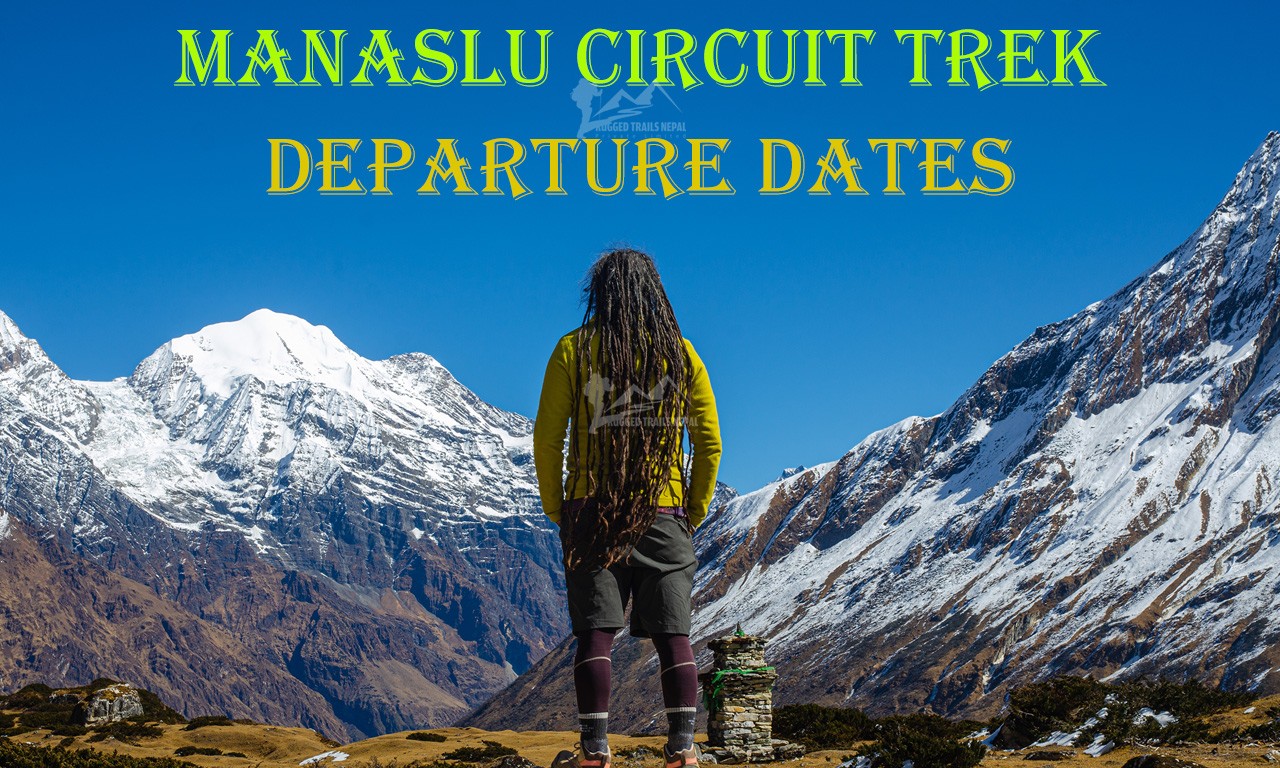
| From | To | Duration | Status | Price From | |
|---|---|---|---|---|---|
| Start date14 Mar, 2026 | End date28 Mar, 2026 | day(s)15 Days | Available | $1495/ person | |
| Start date21 Mar, 2026 | End date04 Apr, 2026 | day(s)15 Days | Available | $1495/ person | |
| Start date30 Mar, 2026 | End date13 Apr, 2026 | day(s)15 Days | Available | $1495/ person |
FAQs
- Is The Manaslu Circuit Harder Than The Annapurna Or Everest Base Camp Treks?
Based on our extensive experience, many guides say the trail is comparable to the Annapurna Circuit Trek but with far fewer tourists. It is a challenging, strenuous, high-altitude journey. While not technically difficult, it requires excellent physical effort as you ascend from 700 meters to 5,106 meters, with constant ups, downs, and river crossings. Compared to Everest Base Camp, the Manaslu Circuit offers a more remote and raw Himalayan experience.
- Why Has The Itinerary Changed From 16 To 15 Days?
To provide the best trekking experience, we have updated our standard itinerary to 15 days effective [March 1, 2026]. This change is a direct response to recent road expansions. By starting our trek at Machha Khola (900m) instead of Soti Khola, we eliminate less enjoyable road walking from the lower sections. This allows us to maximize your time on the pristine mountain trails, focusing entirely on the authentic, high-altitude beauty of the Manaslu region
- What Makes The Manaslu Circuit Special Or Different?
The Manaslu Circuit is a hidden gem, offering a unique blend of the Manaslu and Annapurna regions with significantly fewer tourists. You'll experience a dramatic cultural transition from Hindu villages at lower elevations to ethnically Tibetan communities near the border, witness raw Himalayan landscapes from lush forests to barren alpine zones, and cross the spectacular Larkya La Pass (5,106m). It's for travelers seeking an authentic adventure, not tourists looking for luxury.
- What Are The Real Dangers, And How Do You Manage Altitude Sickness?
The primary danger is altitude sickness, as you reach a maximum elevation of 5,106 meters. Our 15-day itinerary is carefully paced with dedicated acclimatization days in Samagaon and Samdo. We recommend consulting your doctor about preventative medication like Diamox. Our guides are trained to monitor your health, and we emphasize gradual ascent, plenty of fluids, and listening to your body. The trail can also be slippery and is seasonally prone to landslides or snow.
- Are Guides And Permits Mandatory? What Are The Costs?
Yes, a licensed guide is mandatory because the Manaslu region is a Restricted Area. You must also trek with at least one other person. Our package includes all permits:
- Manaslu Restricted Area Permit (RAP): $100/week (Sep-Nov) or $75/week (Dec-Aug) + daily fee.
- Manaslu Conservation Area Permit (MCAP): NPR 3,000.
- Annapurna Conservation Area Permit (ACAP): NPR 3,000.
- What Are The Tea Houses And Food Really Like?
Accommodation is in clean, basic teahouses and lodges. Facilities have improved, with some offering attached bathrooms, especially at lower elevations like in Machha Khola. Shared bathrooms are common elsewhere. Food is generally good with a mix of Nepali Dal Bhat, Tibetan dishes, and basic Western options like pasta and pizza. Important Note: Fresh meat is very rare; local tea shops may have yak jerky, but eggs are the most reliable staple. Menus become simpler at higher altitudes, and the facilities at Dharamsala (Larkya La Phedi) are very basic. This is a teahouse trek, so you do not need to carry food or tents.
- Can I Get WiFi Or Charge My Phone?
WiFi is available in most teahouses up to Samdo, but connectivity is slow and becomes unreliable with altitude. For better service, purchasing a local NTC (Nepal Telecom) SIM card in Kathmandu is recommended, as it provides good 4G data up to Samdo and a few kilometers before Dharamsala. Electricity for charging devices is available in lodges, and it's free. Crucially, electricity for charging is unavailable in Dharamsala, so carrying a power bank is essential.
- Is Travel Insurance Required, And What Does It Need To Cover?
Yes, comprehensive travel insurance is compulsory. Your policy must cover emergency high-altitude medical evacuation up to 6,000 meters, search and rescue, and medical expenses. Please check the exclusions carefully and provide proof of insurance before the trek. List of Best Travel Insurance For Nepal Trekking
- What Should I Pack For The Manaslu Trek?
While we provide a duffel bag and sleeping bag, essential personal gear includes: sturdy, broken-in hiking boots, moisture-wicking clothing layers, a warm down jacket, a 4-season sleeping bag liner, trekking poles, a high-SPF sunscreen and lip balm, a quality headlamp, and a water purification method. A detailed packing list is available on our "Trek Gear List for Manaslu Trek" page.
- What Happens If There Is An Emergency?
Our guides are trained in first aid and altitude sickness recognition. We carry a group first-aid kit. In a serious emergency, we will coordinate a helicopter evacuation to Kathmandu, the cost of which must be covered by your travel insurance. This is why verified insurance is mandatory before you start the trek.
- How Should I Train For The Manaslu Circuit?
Physical fitness and stamina are of utmost importance... training with activities like cycling, running, and walking with a loaded backpack is highly recommended. Incorporating Yoga and breathing exercises can be very helpful.
- What Is The Drinking Water Situation?
You can buy bottled water or boiled/treated water at teahouses. Using water purification tablets or a filter is recommended to reduce plastic waste.
- Is This Trek Suitable For Solo Travelers?
Solo travelers are welcome! We can place you in a small group to meet the permit requirements and provide a shared experience.
- What Is Your Guide-To-Porter-To-Client Ratio?
We typically provide one guide for the group and one porter for every two trekkers. Large group above 10 or depending on the group fitness level and the budget we provide extra sherpa as well.
- Are There Any Cultural Customs We Should Be Aware Of?
Respect local shrines by walking clockwise. Always ask permission before taking portraits of people. The Nepalese phrase 'Dhanyabad' (thank you) is appreciated.
Useful Information
Who Is This (Manaslu) Trek For?
This trek is designed for travelers seeking a raw, authentic Himalayan adventure, not for tourists looking for luxury comforts. Come prepared for both incredible beauty and genuine challenge.
Ideal For: Experienced hikers craving a remote, challenging trail, and fit, determined beginners with a strong mental attitude towards high-altitude trekking.
Families & Children: This is not a standard family trek. However, based on our experience, families with older children have successfully completed it using a custom, extended itinerary. This involves much longer overall trip duration with very short daily walking distances to allow for slow, safe acclimatization. Please contact us to discuss a tailored family plan.
Not Suitable For: Those with knee or ankle problems, a severe fear of heights, or anyone expecting easy, comfortable facilities. It is also not recommended for absolute beginners on a standard-paced itinerary.
Similar to Your Taste
![manaslu tsum valley trekking]()
Manaslu Tsum Valley Trekking
Duration: 23 Days & 22 Nights![lower manaslu eco trek]()
Lower Manaslu Eco Trek
Duration: 14 Days & 13 Nights
Manaslu: A Trek That Taught Me About Fairness, Friendship, and the Mountains Calling
- Hien, VietnamManaslu Circuit Trek - If I write another post because of many pictures, please don't scold me!! I have also been to several treks in Nepal - the kingdom of trekking lovers, this time I chose Manaslu by mistake, partly because of many reviews of the trekking village, and the song of Mr. Ton Dong confirms that this is the most worth visiting in Nepal So I'm also curious to try to see if it's time to get up. There is a little blame about that article while going, the photo does not write deception on every step makes my philosophy experience when going to Upper Mustang is a big goat block like a hill, and Manaslu this time is though different about racial, cultural and economical, the number of exposure to deception of every citizen of dozens of nationalities on this earth will be the same. The fairness of life is here, not anywhere else
Actually a Nepali fan, it's worth visiting every arch, but completing this arch this year has a lot of meaning to me personally. Somehow, Manaslu Circuit Trek has given me much more than much to treasure about everything in this life.
My group has 6 people with 3 members U50 and 3 members a little younger, because knowing that I am very old and weak, I have to carefully order the prestigious landtour, extra porter, and it is really the most suitable decision for a challenge that lies outside imagination of many team members. No 7 support for a group of 6 fools, some people had not exercised for a long time before a journey of 160km from 1000m to 5106m, perhaps crossing Larke pass seems like a no thought...
We have been home for a week, back to the daily routine but perhaps the mountain's reflection is still somewhere, to sometimes find life is so difficult, we will miss the days in the mountains and realize what is the trip so that I can go, how come I can't live in this bustling city heart??!!
I have to thank Agent for always supporting us with all their heart and capacity, there is no team to cheat us to eat, travel, sleep at the right time, hold hands or even push me over dozens of suspension bridges, then Why to have these pictures for you to remember.
I am sharing some pictures in no order just remember that my team arrived Kathmandu on November 7 and left late on November 21. Thanks to your talent, almost the whole group went home with the wrong schedule. But in the light of the Buddha's ten directions, the whole crew was lucky enough to fly home on time as well as have completed perhaps the most miraculous days of life in many meanings!!
To be honest for those who are difficult to eat like me, going to Nepal it becomes something quite fairytale, luggage outside the cold is standard -25 degrees, I have to bring beef noodle, crab bamboo, cold dried sour soup, fried rice, cucumber stew, fried fish salty, salted egg northern egg, sepcialty coffee english tea with fresh central chilli, but still can not swallow food for last 3 days luckily in Dal Bhat in Dharamsala there is green bean soup taste like country green sweet Home, so I live one more day to cross Larke pass with the wind of 5106m high. Moh Buddha, although I have been to Nepal many times, this is the first time I tasted something belonging to Dal Bhat and felt extremely grateful for it.
Every time I go, I scold you because I often play stupid and after scolding you, I continue to go back. Sorry, I'm always stupid because the mountain is calling.
Hardcore Trek Without Any Preparation
- Tam, VietnamI’m at the airport, buzzing with excitement as I wait for my flight to another destination! I want to extend my sincere gratitude to you and all the staff and porters who supported me throughout the trek. It was a real challenge for me to join such a hardcore trek without any preparation, but I did it! Thanks to your incredible support, I made it through. I can't wait to come back to Nepal soon to explore more stunning landscapes. See you soon, and thank you once again!
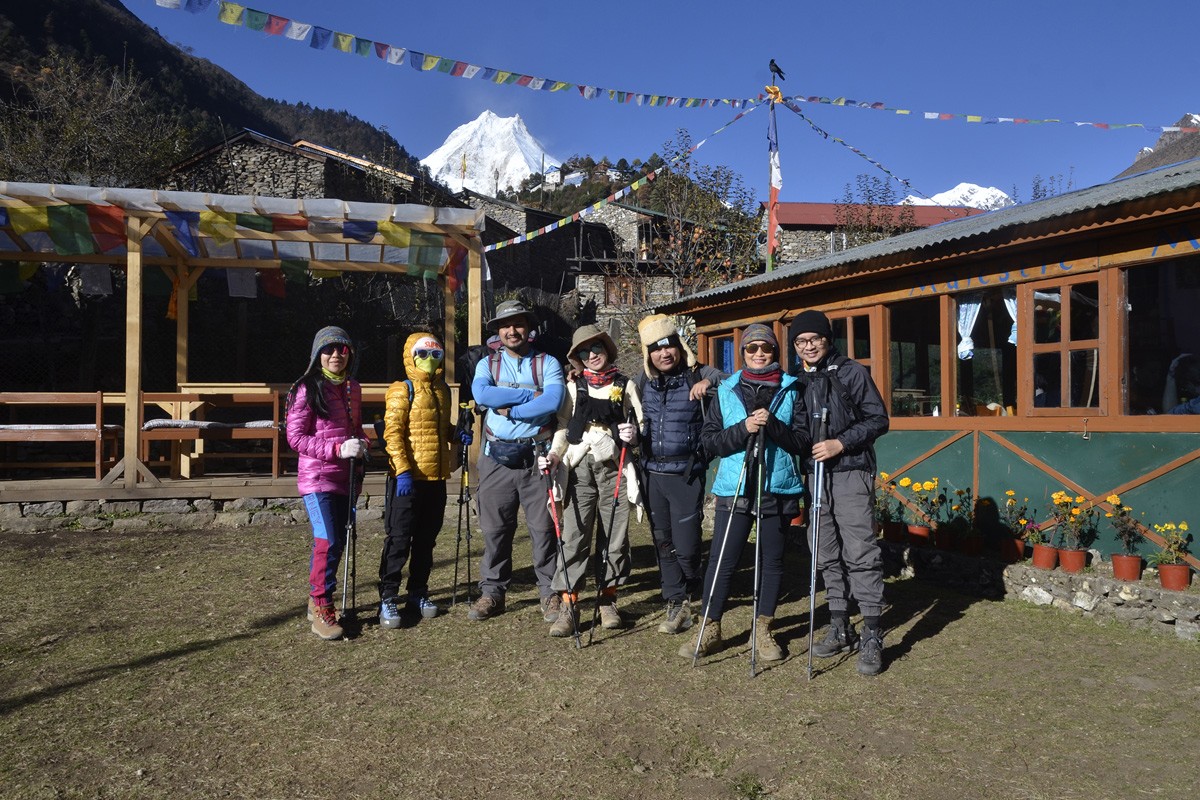
Amazing Manaslu circuit trek
- Renate, AustriaA big thank you to Nirajan and his team for making my Manaslu trek such an enjoyable one. I had a fantastic time in a wonderful country with such nice people!

